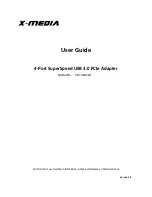
ACTiSYS
ACTiSYS ACT-WF8000U
User’s Manual
Release 1.0a 2004. 4. 10
33 of 51
ACTiSYS Corporation
Network Type
The
WF8000U
adapter can operate in one of two modes, which are specified in the
Mode field of the Configuration menu. Clicking the down arrow at the right of the
Mode field displays the available modes.
Ad-Hoc
- This is the 802.11b Ad-Hoc mode of operation. In “Ad-Hoc” mode, only one
wireless “ cell ” is supported for each different NETWORK NAME. All communication is
done from client to client without the use of an Access Point. “Peer-to-Peer” networking uses
the same NETWORK NAME for the wireless adapters in establishing the network connection.
When “Ad-Hoc ” mode is selected, the utility will provide a selection for setting the channel.
Infrastructure
- This mode of operation requires the presence of an 802.11b Infrastructure. All
communication is done through the Infrastructure, which relays packets to other wireless
clients as well as to nodes on a wired Ethernet network.
Pseudo IBSS
- This mode is for manufacture testing.
Channel
When communicating in Ad-Hoc mode, you must specify a channel on which
communications will take place. This field is grayed in infrastructure mode because
the Access Point automatically selects the channel.
Tx Rate
The Transmit Rate field specifies the rate at which the radio in your WF8000U adapter transmits and
receives data. You can set this to the following fixed rates: 1 Mbps; 2Mbps; 5.5 Mbps or 11 Mbps.
Auto -
When it is enabled, the device will choose the most suitable transmission rate
automatically.
SSID
The name of the wireless network. This name cannot be longer than 32 characters. The default value
is “any”, which will automatically scan and connect the best performance Access point nearby. You
may specify a SSID for the adapter and then only the device with the same SSID can interconnect to
the adapter.
Apply
Click “Apply” button to save and implement the new settings.
Encryption Setting Table
“WEP Key Setting” page allows you to enhance the security of a network. Every station in a secured
network should enable the Encryption function and the values of the Network Key should be the
same.
















































